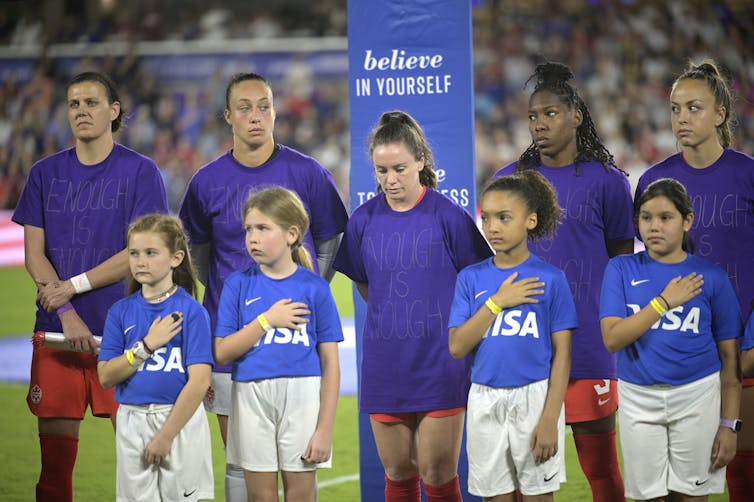
On May 13, Canada hosted its first professional Women’s National Basketball Association game at the Scotiabank Arena in Toronto. The Chicago Sky and Minnesota Lynx graced the hardwood court, adorned with the WNBA logo in the centre.
As a fan, a supporter of girls’ and women’s sports, a former collegiate athlete and a Black feminist scholar who highlights the experiences of Black girls in sports, I could not miss this game. I was fortunate to attend — the game sold out the day tickets went on sale.
This game marked many firsts in the league’s 27-year history: it was the most watched pre-season WNBA game and it set a pre-season attendance record of 19,923.
The game’s success is proof there is an appetite for women’s sports in Canada and bodes well for the possibility of an expansion of the WNBA league north of the border.
A monumental event
The WNBA game provided attendees with an opportunity to honour talented women athletes. I was thrilled to see the throngs of enthusiastic young girls, many attending with their teammates and wearing jerseys to represent their favourite players and teams.
The high demand for WNBA merchandise, the diversity in the crowd and people with signs saying Toronto and Canada are ready for a WNBA team was incredible to witness.
I was able to reminisce with former teammates and coaches and discuss how this game presented a moment of hope and possibility for young girls. I saw the game as a monumental victory for women’s and girls’ place in sports.

Yet, I also understand the opportunity it provides for us to reflect on gender equity in sports. While this was a moment to enjoy and cherish, more work is still needed to bring women’s and girls’ sports to the forefront.
Women’s sport is growing
Although women’s sport has steadily grown in Canada, it remains an untapped market. According to the Canadian Women in Sport report, the professional women’s sport market is estimated to be worth $150 to $200 million, yet it still remains underdeveloped.
Worldwide, the appetite for women’s sport is growing as well. Over half a million tickets have been sold to the upcoming 2023 FIFA Women’s World Cup taking place this summer in Australia and New Zealand.
Private investors continue to support women’s sports as well. There has also been a significant increase in the amount of women’s games being broadcast.
In North America, several new professional leagues have been introduced, including the Canadian professional women’s soccer league and the Premier Hockey Federation. These leagues offer women the chance to play professionally in North America.
But high-performance women’s sports are still not as well-funded as men’s. The WNBA, for example, is only comprised of 12 teams, meaning many players aren’t given the opportunity to play at a high level.
Struggle for gender equity
While there have been a few victories for gender equity in sports — the most notable being the U.S. women’s soccer team winning a 20-year battle for equitable pay — the struggle is ongoing.
The Canadian women’s soccer team saw their funding decrease in February, a few months before the upcoming women’s FIFA World Cup.

Gender and racial discrimination, patriarchal norms, gendered stereotypes and the exclusion of girls and women from sports persists.
Women and girls participate in sports and physical activity far less than men and boys, and are less likely to be coaches and leaders across all demographics. Sports programming for girls continues to face underfunding, a lack of investment and systemic barriers.
2SLGBTQIA+ athletes continue to be underrepresented in sport. Transgender athletes and their allies have been advocating for their right to participate in sports in the face of widespread attacks on trans rights.
The abuse and sexual harassment of women and girl athletes is still a severe issue in Canada that isn’t taken seriously enough.
Achieving equity in sport
Achieving gender equity in sports requires sustained, prolonged efforts. There are a few things researchers, policymakers and sports organizations can do to jump-start the process.
First, researchers should use frameworks like intersectionality and theories like Black feminism to address research gaps in gender and equity in sports. These theories centre and support the authentic stories and experiences of girls and women, and call for social justice and liberation.
Second, sport organizations should seek to increase the representation of Black and Indigenous women and girls within all levels of sport — coaching, leadership and participation. Black and Indigenous women and girls are among the most underrepresented in sports.
Third, better sport policies are needed to address the barriers to sport participation girls face from an early age. Title IX in the U.S., for example, is a gender equity law aimed at increasing participation and equal funding for women and girls in sports and physical activity.
Lastly, gender equity should not be the responsibility of women and girls only — everyone needs to be a part of the process in advocating for the equitable funding of sports programming from middle school through post-secondary education; from playground to professional level.
The WNBA game showcased the legitimacy and immense popularity of women’s professional sports. At the end of the game, the athletes received a standing ovation because the crowd collectively knew that this was more than just a game; it was about the future of women’s sports.
Treisha Hylton does not work for, consult, own shares in or receive funding from any company or organisation that would benefit from this article, and has disclosed no relevant affiliations beyond their academic appointment.
This article was originally published on The Conversation. Read the original article.







